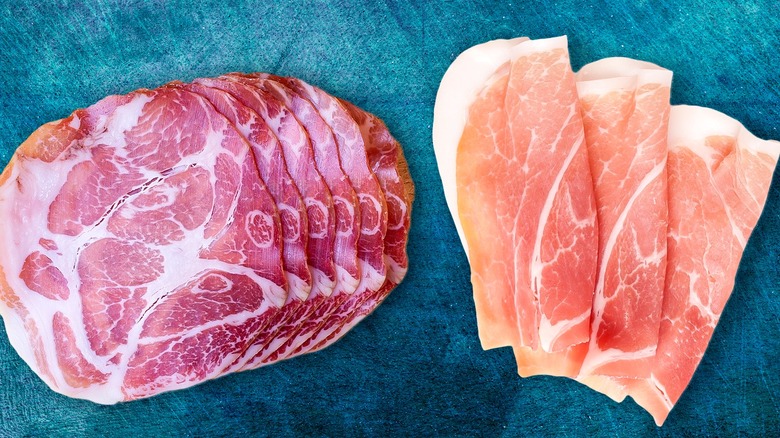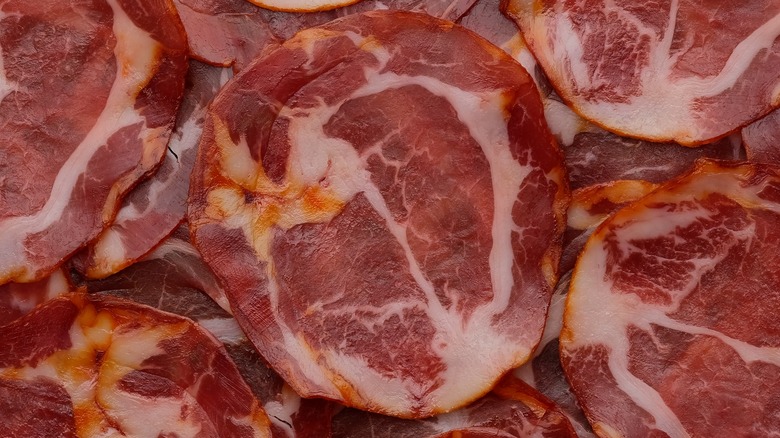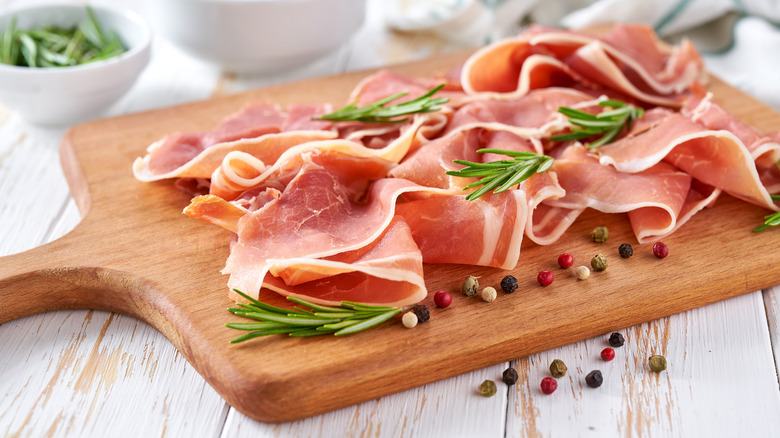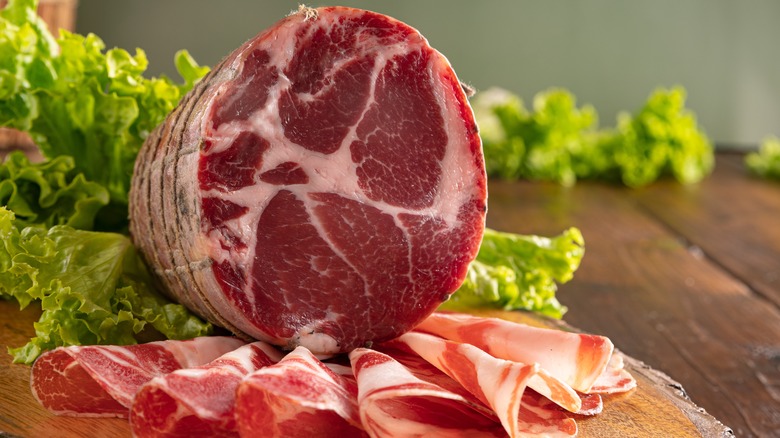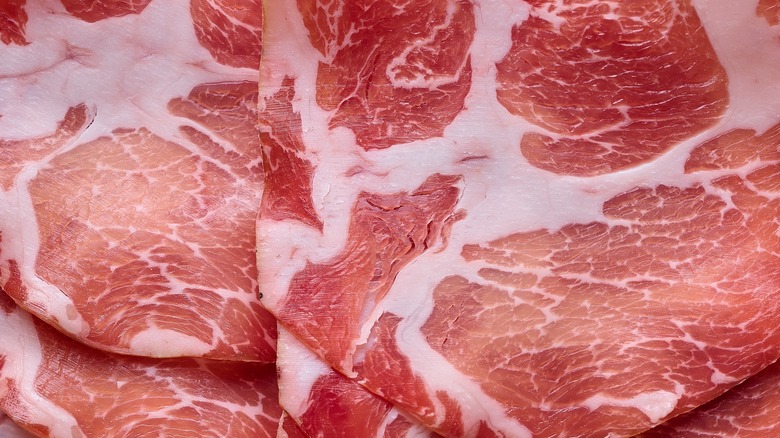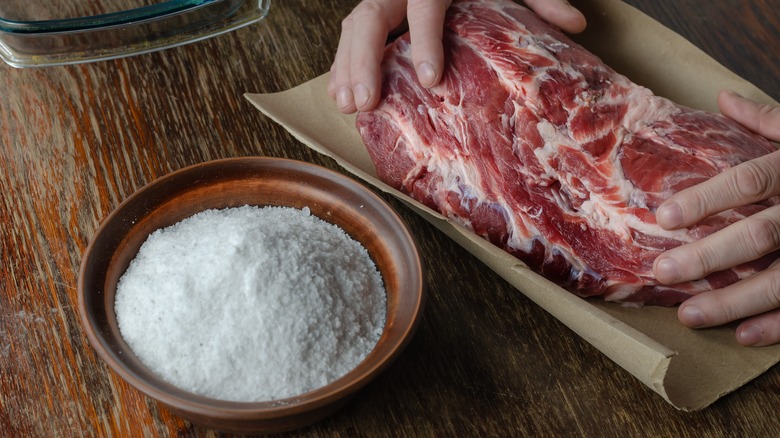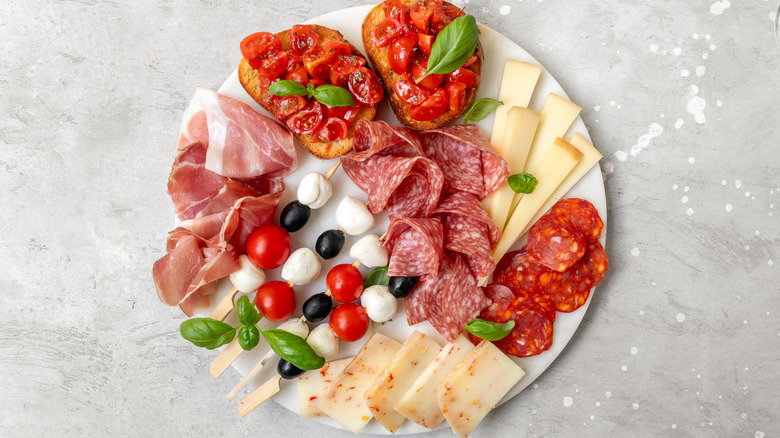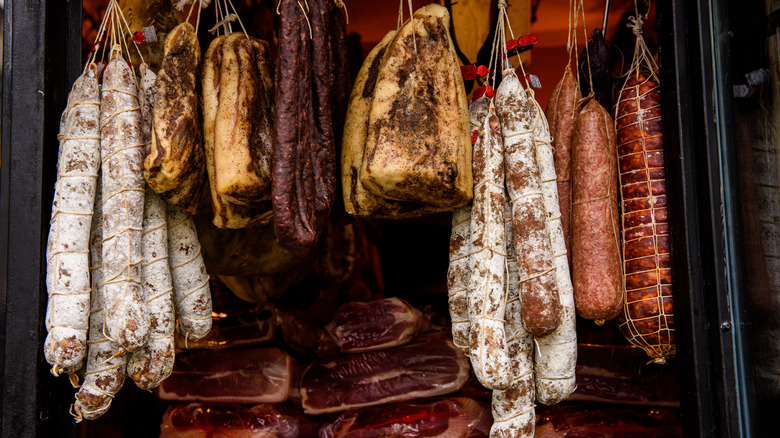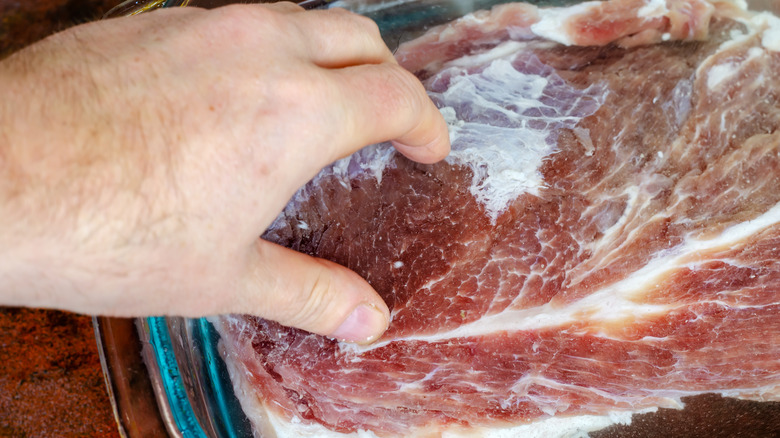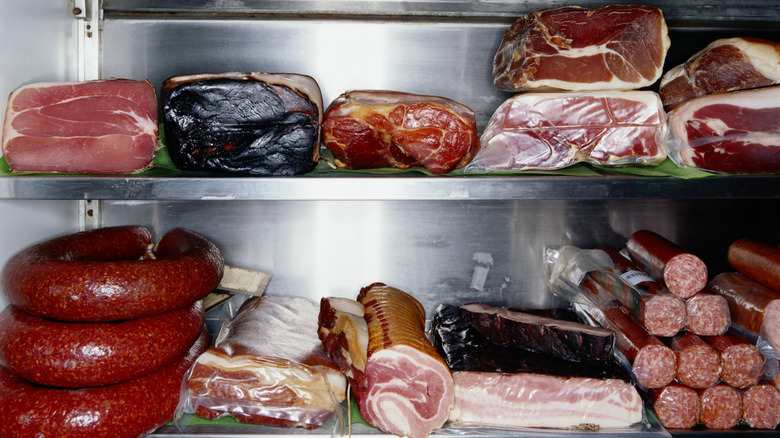What Is Capicola, And How Does It Stack Up To Prosciutto?
We may receive a commission on purchases made from links.
If you or a loved one are from the New York tri-state area, there's a really good chance you've heard the word "gabagool" spoken in relation to cold cuts. Seriously, what does that mean? Like so many words that make the journey from one language to another, "gabagool" first started as something else: capicola. It's an Italian cold cut, not a chatty monster — and while it's similar to prosciutto, there are some key differences that you should know if you're planning on cooking with capicola, ordering a sandwich from an Italian deli, or figuring out what to include on your antipasto or charcuterie plate for a party.
Capicola and prosciutto might both be pork products, but there are some key differences between them, such as what part of the pig the meat comes from, how it's prepared, and how it tastes. In fact, capicola and prosciutto are often served together, along with other salumi ("salumi" basically means cured meats) such as mortadella on a plate with other items from the antipasto course like olives, roasted red peppers, and cheeses. We've put together an extensive guide to capicola, highlighting its unique qualities, history, and uses in the kitchen. Salumi can be confusing at first, but when you're done with our guide, you'll be more confident walking up to the cold cuts counter at your local Italian deli.
What is capicola?
Capicola is an Italian cold cut made from the neck and shoulder cut of pork, specifically the neck to the fourth or fifth rib. It can also be called "coppa." The process for making capicola includes dry-curing the meat for a few weeks after coating the neck and shoulder cut in salt and spices. Once the salt is cleaned from the meat, other spices such as paprika, red and black pepper, fennel, garlic, and anise are added. The spice level can be increased depending on how hot or flavorful you want the capicola to be. After this dry rub is applied, the meat is put in pork casing, hung, and dry-cured for six months. Different regional varieties of capicola exist, each using its own blend of spices to create signature tastes. For example, capicola from Calabria is known for using chili peppers for heat, while capicola from Parma doesn't have much heat at all and relies more on salt.
Capicola is known for its lean-to-fat ratio. There tends to be a lot of fat in capicola, about a 70/30 ratio, which makes this product very tender. You can see the fat content in the meat's characteristic white striations after it's been sliced.
What is prosciutto?
While prosciutto and capicola are often served together (and might initially be confused for one another), they are quite different. Firstly, the truth is that prosciutto is a totally different cut of pork. While capicola comes from the shoulder and neck, prosciutto comes from the leg of the pig. Prosciutto literally means "ham" in Italian, and it can be prepared in two different ways: It can be left uncooked before curing, which is "crudo," or cooked before curing, which is "cotto."
The process for making prosciutto is involved and lengthy. First, the raw ham is salted and refrigerated for a week. Then, more salt is added and the ham continues to rest, usually for about 18 days. The salted ham is then moved to a refrigerated space and kept there for around two to three months. Salt is removed after this time, and the ham is cured for three months. Prosciutto can be cured for anywhere from 400 days to three years.
Prosciutto isn't seasoned like capicola — it's only salted. It's also designated by region and protected by strict agricultural policies. You've probably heard of the most famous kind of prosciutto, which is prosciutto di Parma — ham that comes from the Emilia-Romagna region of Italy. Prosciutto di Parma is required by law to cure for 400 days.
What are the origins of capicola?
The use of processed pork has a long history dating back to the Etruscan era. Archaeological discoveries at Forcello, Italy (which is located near Mantua) show a large number of hog bones present, all around 2 to 3 years in age and with parts of their limbs missing. During the Roman empire, ham products were served at events, and people developed preservation processes so as not to waste any part of the animal.
Cato the Elder, a Roman statesman who wrote "De Agri Cultura" around 160 BCE, detailed how to use salt to make ham: "After the twelfth day remove the hams finally, brush off the salt and hang them for two days in the wind. On the third day wipe them off clean with a sponge and rub them with (olive) oil. Then hang them in smoke for two days, and on the third day rub them with a mixture of (olive) oil and vinegar. Then hang them in the meat house..." (via Project Gutenberg).
It's still unknown when preserved ham transformed into specific kinds of salumi (that is, specific cuts made with specific seasonings and with strict processes), but it's been suggested that capicola originated in two places: Piacenza in the northern regions of Italy and Calabria in the south.
How does capicola look?
Chef Mario Gentile, creator of Italian hotspot Adoro Lei in New York City, told Chowhound that you should look for "color and fat streaks" when assessing capicola. He says it depends on the region it comes from, but the meat should "ideally look from bright pink to bright red" in color. Capicola also has lots of fatty veins throughout, which creates a signature marbled look. The outside of the capicola is coated with the seasoning in which it has been dry-cured. Depending on what seasoning has been used, the rim of meat right under the outside might take on some of the color — in particular, there may be some traces of orange if paprika has been used. If no vibrant seasoning is present, there won't be any bleeding of color from the outside to the inner layers.
Because capicola is an entire cut of pork, it can feature different shades of pink and red. Also, if the meat is slow-roasted, it might become less vivid in color. This is unlike mixed-meat salumi, which is combined with seasonings before being dry cured in casing. Mixed-meat salumi is more uniform in appearance because of the combining process. For comparison, prosciutto has a different shade of pink and can also be pinkish brown in color. Capicola is also a smaller cut than prosciutto.
How is capicola made?
When making capicola, the pork shoulder and neck are covered in herbs, spices, and salt and cured for weeks. Then, the salt is cleaned from the meat and other spices are added. Common spices include paprika, red and black pepper, fennel, garlic, and anise. The spice level can be increased depending on how hot you want the capicola to be. After the meat is dry-rubbed with these spices, it's put in pork casing, hung, and dry-cured for six months.
Feeling ambitious? You can totally make capicola at home. Go to the butcher shop and purchase a fresh pork shoulder, casings, and a salt mix for curing. Season the pork shoulder however you like it. Again, there are traditional seasonings, but you can bring in your favorite spices for a personalized experience or to just experiment with flavor. Trim, salt, season, and then seal the cut in plastic wrap and cure it for a few weeks in the refrigerator. Then, put it in the casing. Prepare to wait — the capicola needs a place to hang and age before you use it — probably about three to six months depending on the size of the cut. The temperature of the space in which you age the capicola should be between 50 and 60 degrees Fahrenheit. When it's done, slice it thin!
What does capicola taste like?
Here's where all those spices come into play, as well as the kind of pork used. For example, Coppa Piacentina, which is made in the Emilia-Romagna region of Italy, must be used from pigs born and raised in Emilia-Romagna or Lombardy. Coppa di Calabria is made from pigs raised in Italy's Calabria region. These are speciality variations that are protected and have been given PDO (protected designation of origin) status. But you will find that capicola can be made anywhere that there's a pork shoulder and the proper conditions to age it. "My favorite is capocollo di Martina Franca, from Puglia," chef Mario Gentile told Chowhound. This capicola is smoked with the bark of the Fragno oak tree and almond tree husk.
In terms of spices, capicola should be smoky in flavor and will probably have more heat than other salumi. That doesn't mean it will always be spicy. Again, there's a lot of wiggle room with spices and the kinds you can use. In terms of taste and texture, it should be salty and have a pleasant creaminess because of the high fat content.
When to use capicola
"Capicolo is best used served as-is," Mario Gentile told Chowhound. He then recommended using it in "cold dishes such as charcuterie boards, tomato salads, with cheese boards, or in sandwiches." Capicola is amazing as an addition to your traditional antipasto plate — place it with other Italian finger foods like olives, roasted red peppers, and Sicilian caponata and cheeses such as provolone, Parmigiano, and sharp cheddar. Figs, pears, and apples are also great to add. Other meats like prosciutto or salami can add some flavor diversity. Don't forget to provide a chunk of Italian bread to go along with all of these goodies!
Capicola is also a not-to-be-missed addition to any Italian sandwich. A traditional Italian sandwich (called a hero, hoagie, or grinder depending on where you're ordering one) usually contains some version of these canonical ingredients: mixed pork meats such as capicola, salami, pepperoni, and prosciutto, along with tomatoes, lettuce, onion, mozzarella or provolone cheese, pepperoncini, and an oil-and-vinegar dressing on an Italian loaf. Of course, there are many variations out there, but capicola is usually included.
When cooking at home, capicola is an easy way to elevate basics. Try wrapping capicola around asparagus or chunks of cantaloupe. "For the 'experimental cooking dishes,' [capicola] can be sliced extremely thin and placed on veal scallopini or chicken dishes after plating," Gentile said. You can also layer it on top of chicken breasts for a simple but robust version of chicken saltimbocca (though you can also use prosciutto).
Where to buy capicola
Capicola can be purchased at any salumeria, delicatessen, or Italian specialty store, as well as in select grocery stores. The range in both quality and price is wide depending on the kind of capicola you choose to purchase. Some come pre-packaged, and some you must get cut freshly from the butcher. You can also purchase pre-cut capicola or order the whole pork shoulder ready for you to cut yourself, depending on how involved you want to be in the whole endeavor.
Although it's always nice to see the meat you're purchasing before it's sliced for you, you can also order capicola online from Amazon, both sliced and unsliced at varying price points. A few places that receive good reviews include: Olympia Provisions, Supermarket Italy, Fortuna's, the Calabria Pork Store, Claro's Italian Market, Eataly, and Meat N' Bone. But it's really in your best interest to go and see the meats for yourself and even sample them. You might be surprised by what you like!
What to look for when buying capicola
When buying capicola sliced, make sure it has that pinkish, reddish coloring, as well as the signature white fat streaks. These will tell you that the cut is fresh, tender, and likely pretty tasty. It should also be thinly sliced, as this is the unbreakable meat rule for true Italian cold cut sandwiches. In terms of freshness, the meat shouldn't smell bad or look grayish. If you're purchasing pre-packaged capicola, check the expiration date.
You should also look at what kind of seasonings you want. As we've discussed, there are many different ways to season capicola during its aging process. While you can't always tell what seasonings have been used just by looking, that reddish-orange hue at the edge of the cut will tell you that there's some paprika or red pepper present and that the meat might be on the spicy side. But remember, you can always ask if you're confused or overwhelmed by a variety of choices. Your deli professional or butcher should be knowledgeable about what kind of capicola they stock and what their flavor profiles are. If you're getting sliced capicola, don't buy more than you need. It should always be eaten fresh.
How to store capicola
Cured meats such as capicola and prosciutto should be stored in a cold place, ideally a refrigerator if they're pre-sliced, at about 40 degrees Fahrenheit. If you have a whole piece of meat that has yet to be sliced, you can store it in a cool cellar. This is because cured meats can grow bacteria if they're exposed to light or oxygen once they've been opened. You should never store capicola in the pantry. If you want to freeze sliced capicola, vacuum-seal it and eat it within one to two months.
Speaking of opening, you shouldn't eat capicola after it's been open for more than five days. It should also be kept in its special deli paper, wrapped up tightly. You can also put the products in an airtight container. Some people even vacuum-seal their cured meats for extra safety and to ensure the meats don't dry out. Pre-packaged meats should feature an expiration date, but keeping them stored properly is the best way to ensure they don't become unsafe to eat (for additional guidelines, here's the last day you can eat lunch meat after opening). If meat looks grayish, discolored, or moldy, or if it smells strange or tastes "off," don't eat it.
